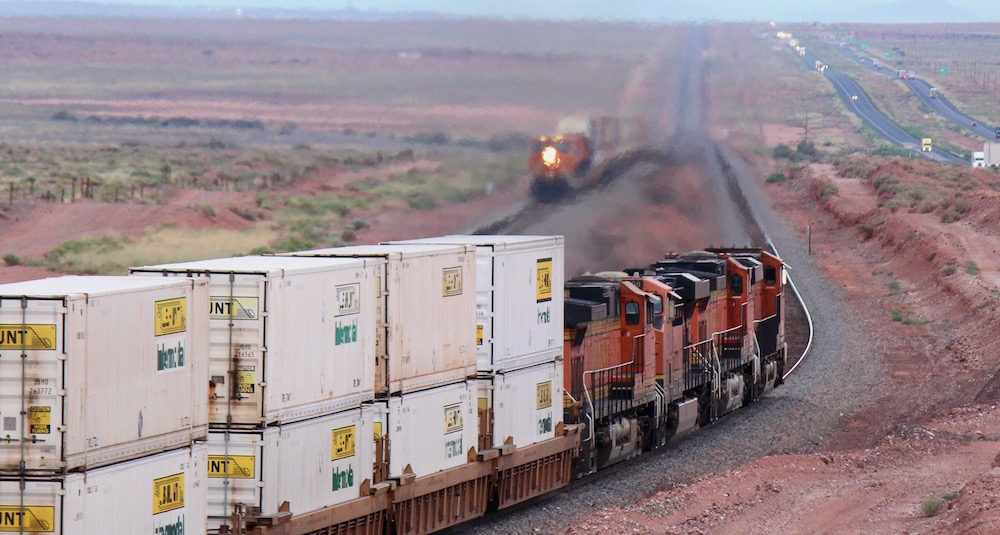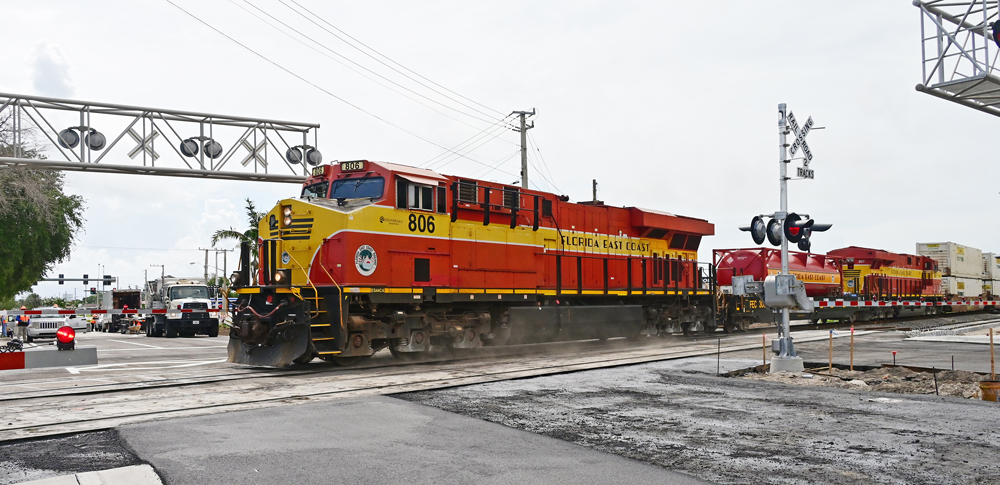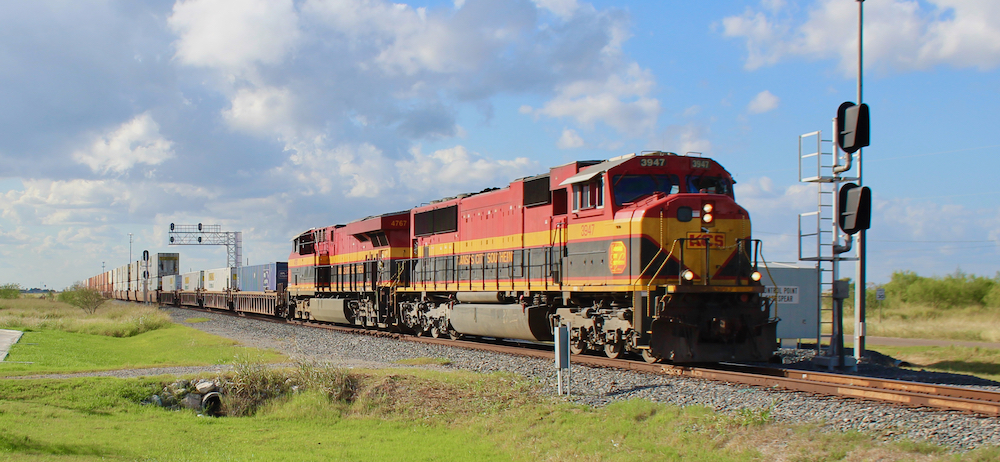
NEW YORK — The Quantum intermodal service that BNSF Railway and J.B. Hunt launched in November — specifically aimed at loads that have never touched rails before — is providing 99% door-to-door on-time performance and is gaining volume, executives said today.
“This is true highway conversion. It’s not intended to be a different service level for existing intermodal,” Darren Field, J.B. Hunt’s intermodal president, told an investor conference. “We are attacking the highway opportunities out there and have good reception and good success and really believe that over the long term we can grow the intermodal business using our Quantum product.”
BNSF and J.B. Hunt did not release specific growth figures for Quantum. The service is a day faster than traditional intermodal, shoots for 95% on-time performance, is built around each customer’s specific transit-time needs, and offers flexible pricing. Plus, J.B. Hunt employees sit alongside their counterparts at BNSF headquarters in Fort Worth, Texas, to monitor Quantum loads and can take steps to expedite them if they fall behind schedule.
BNSF and J.B. Hunt say they have proven the concept since beginning test loads last summer. “It’s one of the things that makes me optimistic about our intermodal future,” says Tom Williams, BNSF’s group vice president of consumer products.
Across the industry, overall domestic intermodal volume has been in the doldrums for about a year due to abundant truck capacity and rock-bottom trucking rates.
J.B. Hunt’s volume was flat overall in the first quarter. But its Transcon volume — which includes any load originating or terminating in Washington, Oregon, California, or Arizona — was up 5%. Its Eastern volume — which includes the rest of Hunt’s intermodal business — was down 7% due to tougher competition, mostly from truckers but also rival intermodal companies.
“It’s just a big fistfight going on there,” Field says.
International intermodal volume off the West Coast has been strong for both BNSF and Union Pacific this year, partly because cargo owners have chosen to send more marine containers all the way to inland points rather than transload the freight into domestic containers.
BNSF believes this a blip in the long-term trend toward transloading more and more imported cargo, particularly freight that comes through the nation’s largest port complex at Los Angeles and Long Beach.
Transloading is the reason why BNSF has proposed its $1.5 billion Barstow International Gateway project. The 4,500-acre complex will include a block-swap yard, support yard, and warehouses and transload centers where goods in international containers can be transferred to domestic boxes for the eastbound trip to inland markets via rail. The idea behind BIG is that it will ease congestion at the ports of Los Angeles and Long Beach and eliminate the 80-mile dray moves for freight that’s currently trucked from the ports to the Inland Empire for transloading before being trucked to one of BNSF’s Southern California intermodal terminals.
BNSF currently expects BIG, which is in the permitting process, to open in late 2027 or early 2028, Williams says.
Williams was asked about comments that Berkshire Hathaway Chairman Warren Buffett made in his annual letter to shareholders about BNSF’s need to improve its profit margins and subsequent comments that Berkshire Vice Chairman Greg Abel made at the company’s annual shareholder meeting this month regarding the need for BNSF to bring its costs in line with demand. Does BNSF have more of a focus on profit margins now and if so, how will that affect intermodal?
In order to be successful with intermodal and carload freight, BNSF must be cost-competitive with other railroads and trucks, Williams says.
“We are not de-emphasizing intermodal,” he says, and the railway remains committed to maintaining its intermodal leadership.
Field and Williams spoke at the Wolfe 17th Annual Global Transportation & Industrials Conference.














Dead horse-beating but those hedge funds’ main customers are pension funds like CALPERS and the UAW’s. They are the culprits. Plus the next time your med bill is picked up by your health ins those hedgies are how they got that money. Pension fund Socialism I call it. Do you really want the pre-UknowHoo tax rules again where the Rich deduct interest and taxes on vacation homes galore like a Vt Senator?
To John Rice, yes go on. That was an interesting comment. Be nice to hear more. The RR never explains why they do certain things and only the top dogs give vague explanations. I feel only outsiders that are knowledgeable can explain things to an average worker like myself.
The reckoning is coming for pacific coast based intermodal. 2035 is when BNSF has to go all green. Lets see how JB Hunt deals with that.
To quote my former Santa Fe boss Don McInnes (from a 1990 article in Progressive Railroading Magazine), “We market our premium service something like the way the Railway did our famous Super Chief passenger train. If you wanted to ride the Super Chief, you were required to pay an extra fare…We feel very strongly there is a growing niche for this type of intermodal service.” (as first reported by this writer in the July 1998 edition of TRAINS Magazine)
My observation at the time was that “Customers would pay a truly premium price for truly premium service.”
“The idea behind BIG is that it will ease congestion at the ports of Los Angeles and Long Beach and eliminate the 80-mile dray moves for freight that’s currently trucked from the ports to the Inland Empire for transloading before being trucked to one of BNSF’s Southern California intermodal terminals.”
I imagine the Teamsters Union will have some complaints about that, and we all know who has this administration’s ears. Hint – it isn’t BNSF…
I believe most of the truck drivers at the ports are independents. How many of then will survive the state’s crazy green rules for electric trucks is another question.
Good to see an administration respect and pay attention to labor. The previous one cut taxes primarily for those earning $400K or more in the ill-advised TCJA of 2017. The 1% has enjoyed more than 40 years of almost nonstop income tax cuts and capital gains cuts. Not helpful to those who work for a living. And lots of debt since Mr. Clinton.
That is because the “trickle down” theory of releasing more gains to be reinvested into the domestic industry has instead been co-opted into investments in ever growing hedge funds.
Hollywood, railroads, airlines, Las Vegas, real estate, the music business, broadcasting, just to name a few…. have been transformed into a form of equity value machines where worth is measured in 30 day increments, when in pre-hedge days it was measured over years.
This is creating an ever increasing blowback for the generation (Gen Alphas) who can’t get a decent paying job enough to pay for ever increasing rents or mortgages. Boomers are holding their houses, working later in life, and enjoying the growth of their 401k’s from the stock repurchase plans. This is creating living wage demands, drives for unionization of workers, and a rash of homelessness.
Shall I go on?